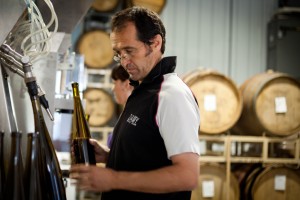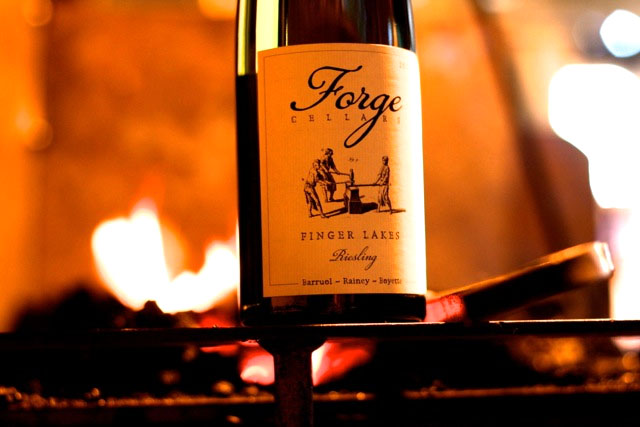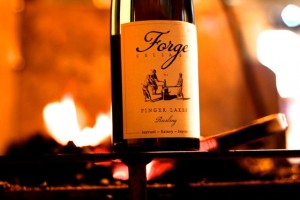Before the final presidential debate, several members of the news media were accidentally emailed a debate recap by one of the campaigns. It described what an outstanding performance their candidate had just displayed. Of course, the review was written hours before anything, you know, actually happened.
Spirited discussion is healthy, but prejudgment should be unacceptable, and that has affected the conversation about Forge Cellars‘ first vintage of riesling, the recently released 2011.
So what’s the big deal? Well, this is the first Finger Lakes riesling (to our knowledge) aged entirely in oak, not stainless steel or some other container. Granted, it didn’t spend much time in wood — about seven months — and the oak was not at all new. Some of the French barrels were eight years old, some about half that.
But in the Finger Lakes, oak and riesling have not been permitted to marry. They’ve never really even dated. Privately, some winemakers recoiled at the notion, with one telling me, “That’s not going to work.” Even Justin Boyette, Forge winemaker and co-owner, told me, “I felt like it wouldn’t be a viable option for the Finger Lakes. I automatically thought of big, oaky California chardonnays.”
Boyette then learned what many of his colleagues in the Finger Lakes did not know: riesling has long been aged in wood in Europe, Germany especially. In fact, here’s what Chambers Street Wines, the uber-cool wine store in New York City, wrote about the rise of German winemaker Karl Schaefer:
“He makes crisp, chiseled, elegant Rieslings in very large oak barrels… to preserve clean mineral character and vibrant but subtle fruit flavors. Jan’s wines are linear and focused in the best sort of way.”
Doesn’t exactly sound like the wood has turned the wine into a fat, oaky mess, does it?
This is where Rick Rainey, Forge co-owner, swoops in to deliver an outstanding line, which his colleagues have now heard many times: “We’re obsessed with saying wines are over-oaked, when in reality they’re almost certainly just under-wined.”
There’s a ring of truth to Rainey’s point (which he confesses to stealing from Jean-Marie Guffens of Verget in the Maconnais). Consider some of the world’s most prolific, structured red wines. Many of those wines are aged in 100% new barrique, and yet the wine does not succumb to the wood. Many of those wines are aided by the wood, which provides structure and mouthfeel.
“Barrique has a bad rep,” Rainey told me. “It’s the use of barrique to prop up wines that’s the problem. Start with bad fruit? You’re going to get bad wine. Oak won’t save it. But start with great fruit? You have options.”
And yet some winemakers and some potential customers are judging the wine without having tasted it. That’s absurd. Wine hits us all in different ways, and undoubtedly some people will not like Forge Riesling. But to decide it’s not good, or even worse, a mistake — before experiencing it? This region is way too young for that.
 The Forge team explains their decision to use oak
The Forge team explains their decision to use oak
Winemaker and co-owner Louis Barruol made the call to go with old wood for the Forge Riesling. Barruol told me that he is not a fan of stainless steel, and regarding riesling, “It has something in common with sauvignon blanc: it doesn’t like much young oak. New or one year old. That tends to kill the wine’s minerality. Viognier and chardonnay are the opposite.”
So how about older barrels? Barruol continued, “Old oak makes riesling go in such interesting dimensions. Without it, some aspects of it remain hidden. Let’s remember that people use oak in Alsace for riesling for a long time.”
The goal, Barruol said, was to use oak to broaden the mouthfeel of the wine without losing the crackling acidity. Forge Riesling is very dry, only about three grams of residual sugar, but the result comes off much different.
“I enjoy telling customers after they taste that there’s oak there, because so often they have no idea,” Boyette said. “People are perceiving the texture, the mouthfeel, as residual sugar. That means it’s working. The oak isn’t blocking the aromatics or the flavors, but instead it’s kind of stretching out the flavors in the mouth. It’s rare to get nice acidity with a long mouthfeel.”
This approach happens to be the same one employed by Ravines Wine Cellars winemaker Morten Hallgren, who has experimented with old barrique on certain lots of his Argetsinger Riesling. Hallgren told me the practice shouldn’t be controversial, but “sometimes in the Finger Lakes it seems that you can’t try different approaches without people thinking it’s wrong.”
 Outstanding fruit is the key
Outstanding fruit is the key
There is a veritable ocean of overoaked red wine, available for the low low price of about $5 a bottle on up to the luxury levels. And white wines can suffer just the same, even in old barrels. So Forge hired Phil Davis of Damiani to be their vineyard liaison, seeking out the best sites with the best practices. That led them to three sites on the eastern side of Seneca Lake: Sawmill Creek Vineyards, Leidenfrost Vineyards, and Harvest Ridge, along with Sunrise Hill Vineyard on Cayuga Lake.
Barruol remarked that the sorting of the 2011 fruit was perhaps more rigorous than even the meticulous sorting that is the norm in his home of Gigondas, France.
So how is it?
There is something in the Forge Cellars 2011 Riesling for everyone who has a preconceived notion. If you go looking for oak, you can find it. It doesn’t thump you in the mouth, but there is an echo of wood in the nose. And if you’re looking for evidence that the approach succeeded, you’ll find it in the added length, the “flesh on the bones,” as some would say.
My suspicion is that foudres, a much larger oak vessel, would be the most effective option, but you won’t find many foudres in the United States. Morten Hallgren has looked into bringing some over from Europe, but for now, it’s cost-prohibitive.
But I’m also surprised at my response to the wine; after all, I’m almost irrational in my view that chardonnay doesn’t handle oak as well as many winemakers believe. I prefer unoaked chardonnay most of the time. So why am I intrigued at the possibilities here?
I think it starts with my concern that many Finger Lakes dry rieslings have become death rays, a kind of electrocution-by-acidity experience.
A bit too severe, not enough texture, etc. The Forge Riesling starts with excellent fruit, then seeks to gently add texture through the use of old barrels. It makes sense in theory, and the first vintage indicates there is promise.
Or forget promise; I’ve seen customers walk off with a case. And I’ve dined with writers who like the complex nose of ginger, lemon curd, and creamy peach. There’s no butter here, no brown sugar, no sense that the wood is dominant. And it still crackles on the palate, a mouthwatering wine that offers unusual length, as Boyette pointed out.
The Forge team will have to get used to mixed reviews. I’ve heard some winemakers predict that the finished product will not “seem like a Finger Lakes riesling.” That’s where we need to be careful. With 115 wineries in the region, the typical riesling still isn’t all that impressive. The typical riesling falls into a narrow range of green apple/sour apple/lime. There is a world of aromas and flavors outside of that box. There’s no reason to lecture wineries that are attempting something different — even if that different is rooted in old-world tradition — into something more banal and predictable.
But neither is there a reason to assume every venture into new territory will succeed. In this case, I think Forge has created something compelling. It’s a wine that might polarize a room of wine lovers. I’m especially eager to check out the 2012 vintage. I have no problem with people who don’t like the wine, assuming they’ve tasted it. And I shudder for a region that occasionally assumes it has all the answers already. Rainey has taken the criticism in a kind of always-sunny stride, saying, “There are two camps: those that enjoy getting to know the unknown, and those that don’t. It doesn’t disappoint me because it has happened before in other regions.”
Rainey can’t fully hide his frustration, however, with the fact that so much attention is on the use of oak instead of on the Forge team’s high overall standards. “I find it a bit unfortunate,” he said, “that some people bypass all the other work that is done, the sorting, the meticulous fermentations, the selection of growers and how we work with them… The barrel, for me, is so matter-of-fact that I guess it’s the one thing I scratch my head over.”
It’s also worth mentioning that Forge Pinot Noir has the potential to eclipse the Riesling, but the pinot has not yet been released, and for now, everyone is talking about the maiden white in the portfolio.
Already finding an audience
Forge wines are already being poured in several hot restaurants in New York City and Washington, DC. In DC, the riesling is offered at Adour by Alain Ducasse, Brasserie Beck, and Proof. In NYC, Blue Hill restaurant began pouring Forge this month.
It doesn’t hurt to have Louis Barruol’s sterling reputation and track record, but Rainey has found that he still has to hand-sell. “Louis is great, but they have to love the wine first,” he said. “We’ve hardly told anyone we exist, and our wines are moving. We have a lot to learn and we know we have so far to go, but it’s hard not to get excited.”
Perhaps the most endearing aspect of the Forge trio is that Barruol, Rainey and Boyette are all thrilled to engage in spirited debate about their wines. There is plenty to discuss. After tasting, of course.


